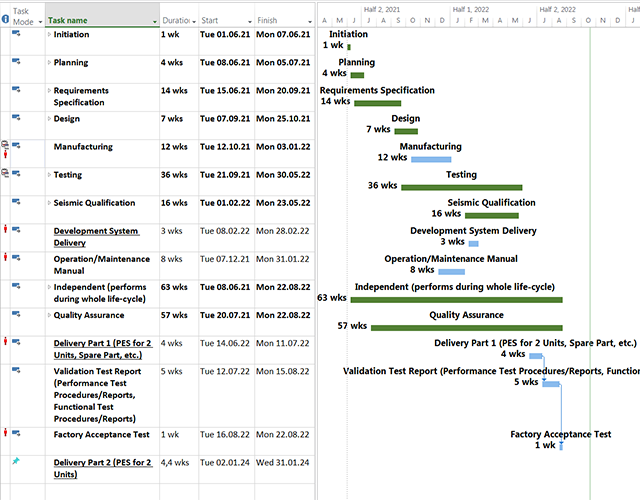
PROJECT MANAGEMENT
Our project management team continuously monitors status of projects, evaluates the progress of teams’ work to meet project objectives for the Customer and implements efficient change management if necessary.
Effective communication with the customer is vital to ensure transparency and efficient planning and control.
Risk assessments help identify challenges, reevaluate priorities, and develop risk mitigation strategies. Regular control and systematic evaluation drive real value for the project.
PROJECT MANAGEMENT
Our project management team continuously monitors status of projects, evaluates the progress of teams’ work to meet project objectives for the Customer and implements efficient change management if necessary.
Effective communication with the customer is vital to ensure transparency and efficient planning and control.
Risk assessments help identify challenges, reevaluate priorities, and develop risk mitigation strategies. Regular control and systematic evaluation drive real value for the project.
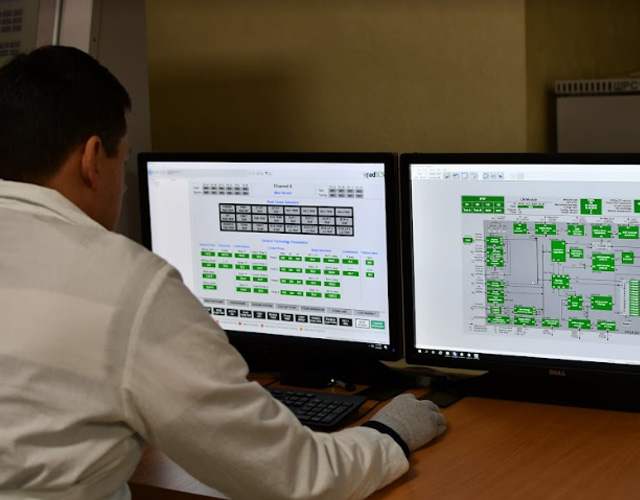
DESIGN
Design begins with brainstorming and conceptualizing stages of working out the technical requirements for the product to offer the customer a reliable, easy-to-use and cost-effective solution. It is a key process to transporting a pre-defined set of inputs into a specific and valuable output within the framework of the quality standards required for the project.
Effective communication with customers helps designers understand customer needs, wants and problems to be solved.
In addition to utilizing state-of-the–art technologies in large-scale modernization projects, Radics implements reverse engineering approach upon the Customer’s request.
Our designers are continuously utilizing innovative technologies to ensure our products offer the most advanced technical value.
DESIGN
Design begins with brainstorming and conceptualizing stages of working out the technical requirements for the product to offer the customer a reliable, easy-to-use and cost-effective solution. It is a key process to transporting a pre-defined set of inputs into a specific and valuable output within the framework of the quality standards required for the project.
Effective communication with customers helps designers understand customer needs, wants and problems to be solved.
In addition to utilizing state-of-the–art technologies in large-scale modernization projects, Radics implements reverse engineering approach upon the Customer’s request.
Our designers are continuously utilizing innovative technologies to ensure our products offer the most advanced technical value.
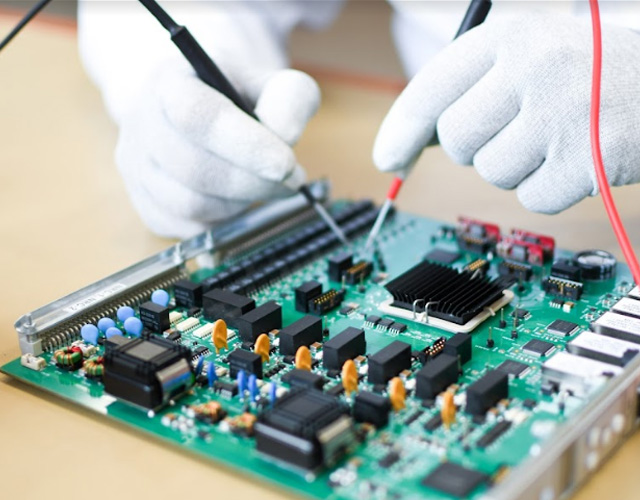
TESTING (V&V)
Testing is a key element in the project, ensuring that a product development process strictly meets the requirements of the specification provided by the customer. It is a flexible process and is adapted to various client needs: from testing small items as part of reverse engineering process to testing integrated I&C systems based on RadICS platform. Testing throughout the project is important because it allows to find product bugs before the product is released for the Customer’s approval.
One more goal of testing is to provide the project management team with independent information on the project status.
In our company, testing is carried out by the Verification and Validation teams that are both independent from the design group. The testing work is organized in compliance with all applicable standards, including IEEE 1012, IEC 61513, and others.
Our engineers use a wide range of tools and methods to perform comprehensive and complete product testing. Automated testing is a preferable method as it reduces the likelihood of human errors. A wide range of equipment is used by highly qualified engineers to perform the final testing of integrated product.
TESTING (V&V)
Testing is a key element in the project, ensuring that a product development process strictly meets the requirements of the specification provided by the customer. It is a flexible process and is adapted to various client needs: from testing small items as part of reverse engineering process to testing integrated I&C systems based on RadICS platform. Testing throughout the project is important because it allows to find product bugs before the product is released for the Customer’s approval.
One more goal of testing is to provide the project management team with independent information on the project status.
In our company, testing is carried out by the Verification and Validation teams that are both independent from the design group. The testing work is organized in compliance with all applicable standards, including IEEE 1012, IEC 61513, and others.
Our engineers use a wide range of tools and methods to perform comprehensive and complete product testing. Automated testing is a preferable method as it reduces the likelihood of human errors. A wide range of equipment is used by highly qualified engineers to perform the final testing of integrated product.
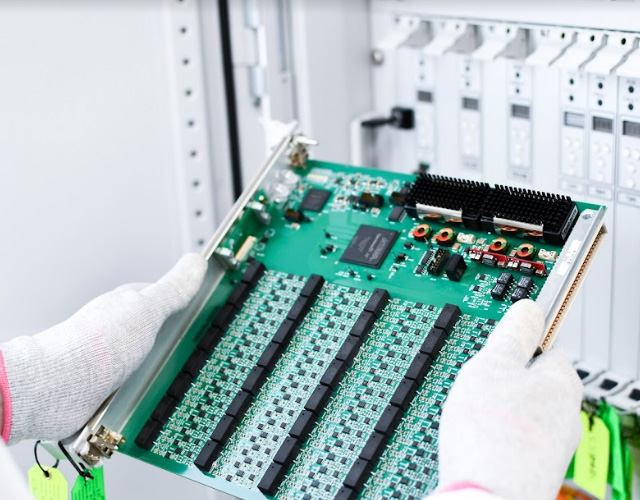
COMMERCIAL GRADE DEDICATION
Our commercial grade dedication personnel use verification procedures to obtain certain assurance that a commercial grade item can be used in the nuclear industry and performs its intended safety function. Our team has extensive experience and all necessary skills to perform acceptance process by identifying the critical characteristics of the item and using the following dedication methods: Special tests and inspections, Commercial grade survey, Source verification, Acceptable supplier/Item performance record.
Our approach to commercial grade dedication ensures that RadICS Platform –based equipment delivered to nuclear facilities meets the high-quality requirements specified by the most demanding customers and governing regulatory bodies and can be used for safety and safety-related applications.
COMMERCIAL GRADE DEDICATION
Our commercial grade dedication personnel use verification procedures to obtain certain assurance that a commercial grade item can be used in the nuclear industry and performs its intended safety function. Our team has extensive experience and all necessary skills to perform acceptance process by identifying the critical characteristics of the item and using the following dedication methods: Special tests and inspections, Commercial grade survey, Source verification, Acceptable supplier/Item performance record.
Our approach to commercial grade dedication ensures that RadICS Platform –based equipment delivered to nuclear facilities meets the high-quality requirements specified by the most demanding customers and governing regulatory bodies and can be used for safety and safety-related applications.
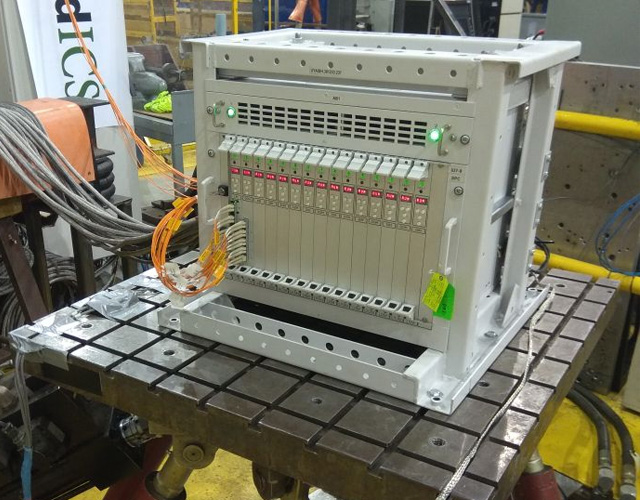
EQUIPMENT QUALIFICATION
Radics’ Equipment Qualification and Calibration Department has developed a systematic approach to ensuring that RadICS platform-based safety systems manufactured for nuclear facilities and process industries with high level of safety requirements meet the relevant quality standards.
In a certified testing laboratory, we perform a wide range of required equipment qualification testing to check equipment capability to perform designated safety functions on demand under postulated operational conditions, including harsh environmental conditions, seismic vibration, radiation, electromagnetic compatibility, etc.
Our qualification team is familiar with all recognized international standards and regulatory guidance documents and varies their qualification practices and methods on the basis of the equipment’s safety significance, type and other considerations.
Upon customer’s request, we qualify equipment within the regulatory boundaries and internationally recognized laboratories, specified by the end-users.
EQUIPMENT QUALIFICATION
Radics’ Equipment Qualification and Calibration Department has developed a systematic approach to ensuring that RadICS platform-based safety systems manufactured for nuclear facilities and process industries with high level of safety requirements meet the relevant quality standards.
In a certified testing laboratory, we perform a wide range of required equipment qualification testing to check equipment capability to perform designated safety functions on demand under postulated operational conditions, including harsh environmental conditions, seismic vibration, radiation, electromagnetic compatibility, etc.
Our qualification team is familiar with all recognized international standards and regulatory guidance documents and varies their qualification practices and methods on the basis of the equipment’s safety significance, type and other considerations.
Upon customer’s request, we qualify equipment within the regulatory boundaries and internationally recognized laboratories, specified by the end-users.

CUSTOMER SUPPORT
Customer Support has always been the priority for our company. Using a 24-hour communication channel we respond directly to customers to provide them with quick, easy, and friendly consultation, whatever the problem is.
As safety and reliability of power plants cannot be achieved solely by the quality of hardware, we provide for customers personnel training in a specially equipped training center which has samples of the various types of I&C systems and simulators to model different operating scenarios and provide timely and effective advice.
In case of RadICS platform-based equipment, the customer’s team is trained to work with Radics’ Proprietary Configuration Tool (RPCT), which allows them to independently change the application logic and customize screens to display service information for their convenience.
A reliable system for monitoring and managing design documentation for delivered products helps meet the customer’s requests for additional equipment or spare parts at any time after initial supply.
CUSTOMER SUPPORT
Customer Support has always been the priority for our company. Using a 24-hour communication channel we respond directly to customers to provide them with quick, easy, and friendly consultation, whatever the problem is.
As safety and reliability of power plants cannot be achieved solely by the quality of hardware, we provide for customers personnel training in a specially equipped training center which has samples of the various types of I&C systems and simulators to model different operating scenarios and provide timely and effective advice.
In case of RadICS platform-based equipment, the customer’s team is trained to work with Radics’ Proprietary Configuration Tool (RPCT), which allows them to independently change the application logic and customize screens to display service information for their convenience.
A reliable system for monitoring and managing design documentation for delivered products helps meet the customer’s requests for additional equipment or spare parts at any time after initial supply.

